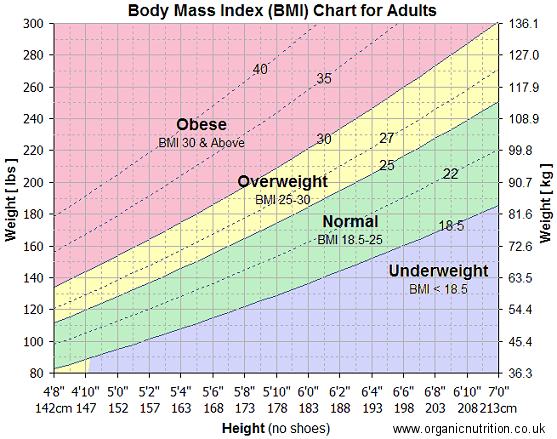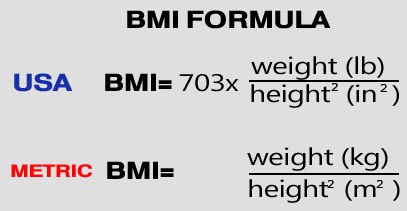What is BMI? (Body Mass Index)
Each one of us has a different height and a different weight. Someone who is 5 feet 9 inches high may weigh 8 stone and someone who is 4 feet 11 inches may also weigh 8 stone. One of these people may be considered to be underweight, while the other may have a ‘normal’ weight.

How is it possible to tell if you are under or overweight for your height? The Body Mass Index is a calculator for working out if your weight is at a healthy level for your height. So it gives more information that the traditional weighing scales which just give you body weight.
But have you heard of BMI? BMI stands for Body Mass Index which is a formula that has been developed to test how much body fat we have in relation to our weight. It is also useful to know how far a person is from what is considered ‘normal’ weight for their height, whether this be under or overweight.
BMI Calculator
There are many BMI calculators available online and here is a link to a very simple to use on the
NHS site:
https://www.nhs.uk/Tools/Pages/Healthyweightcalculator.aspx
It is possible to work out one’s BMI with a simple calculation. Here is a body mass formula that you can use to work out the ratio of your body weight to your height.
BMI Formula
In order to work out your BMI with a manual formula as is given below, you need to have 2 figures to hand, one is your weight in kilos and the other is your height in metres.
The formula for Body Mass Index is as follows:
You can work out your BMI either by using pounds and inches or you can use the more common European method which uses kilos and metres.
It sounds more complicated than it is. It is really rather simple to work out. Here's an example:
Firstly you need to weigh yourself. Let's say you weigh 75 kilos.
Then measure your height. Let's say it is 1.68 metres

Divide your weight in Kilos by height in Metres and then divide by your height in Metres again.
So in our example the BMI figure would be:
75 divided by 1.68 = 44.64
And then divide the above answer by your height once again to give the final result:
44.64 divided by 1.68 again = 26.57
The BMI figure is 26.57 and when you look at this figure on the chart it suggests that the person is slightly overweight for their height.
Men and women use the same BMI chart
It may seem a little strange that men and women use the same BMI chart, especially as the relationship between height and weight can appear to be rather different when comparing the sexes.
The reason the same chart is used is because the health risks of being overweight increase at about the same BMI for both males and females. When a person's BMI rises about 25 the health risks related to being overweight also start to rise for men and women.
It is important to realise that the Body Mass Index is a way of measuring the possible likelihood of greater health problems brought about by weight.
See below for the BMI summaries.
The BMI lets you know if you have a normal weight for your height or if you are underweight, overweight or obese.
- BMI below 18.5 is underweight.
- BMI between 18.5 - 24.9 is considered to normal weight.
- BMI between 25 - 29.9 is considered to be overweight.
- Over and above 30.0 is considered to be an obese BMI.
How much do you weigh in Kilos?
If you don’t know your weight in kilos and only know it in stones and pounds, then read on to work out your BMI. In order to use the manual BMI calculator, it is necessary that you find out your weight in kilos. So firstly you will need to convert this to kilos.
Here is a simple way to convert your weight into kilos.
Work out how many pounds you weigh.
1 stone = 14 pounds.
10 stones = 14 x 10 = 140 pounds.
10 stone 4 pounds = 144 pounds.
Multiply the pounds into kilos by multiplying pounds x .45.
144 pounds x .45 = 64.8 kilos
How tall are you in metres?
When working out the manual BMI, it is necessary to know how tall you are in metres.
Here is a simple way of converting feet into metres.
Work out how many inches tall you are.
1 foot = 12 inches
5 feet tall = 60 inches
5 feet 5 inches tall = 65 inches.
Multiply the inches into metres by multiplying inches x .0254
65 inches x .0254 = 1.65 metres
BMI formula using the above example:
Weight of 64.9 kilos divided by 1.65 metres x 1.65 metres
64.9 divided by 2.72 = 23.86
BMI = 23.86
Hopefully you can use this information to help work out if your body weight is in proportion to your height.
BMI is only a guide even though it can be a useful one
It should be realised that this figure is only a guide. It can get out of range even though the person is very healthy.
For example a body builder or rugby player can be very heavy for their height and have a high Body Mass Index.
At the other end of the spectrum a very healthy runner can appear to be underweight for their height compared to the chart.
In both of these extremes this can be misleading and this has to be taken into account.

